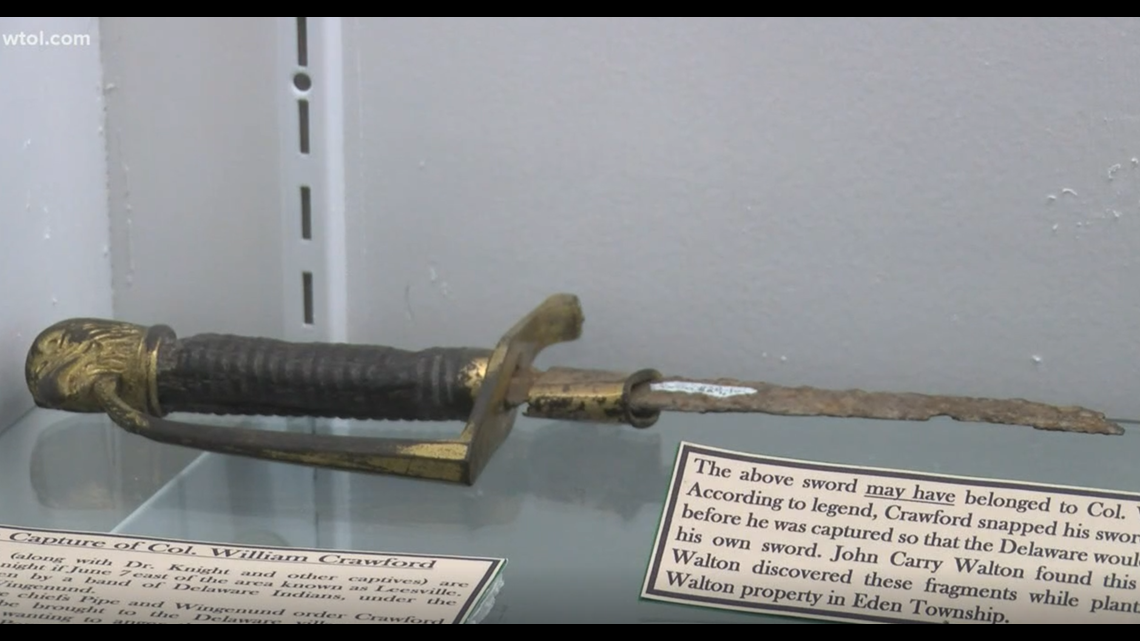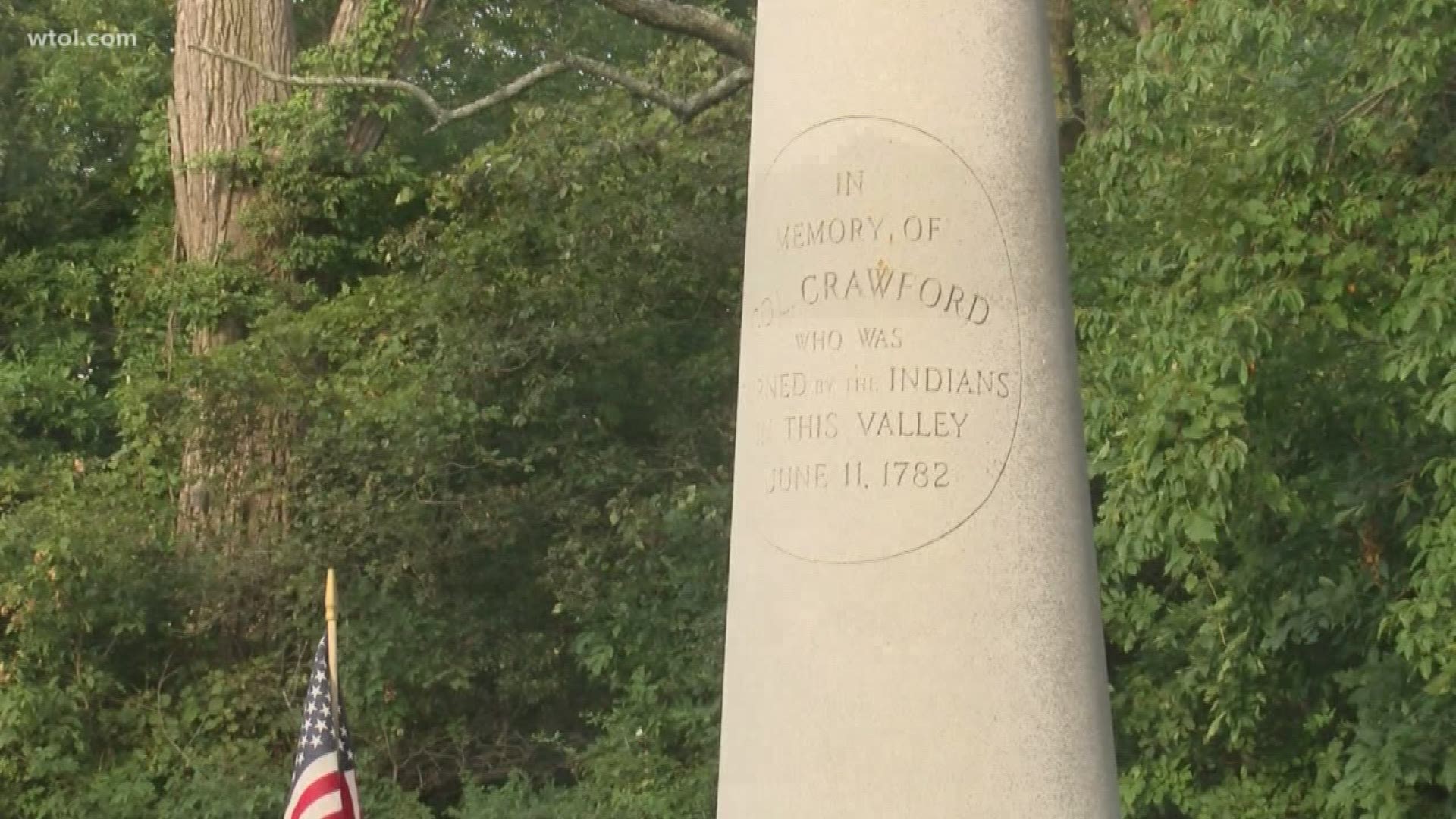UPPER SANDUSKY, Ohio — The drivers on State Route 199 that pass by Tymochtee Creek in Wyandot County may not know that along the banks of that stream lives a legend; the sad legend of Colonel William Crawford.
In June of 1782, Crawford and others in his regiment were captured by Delaware Indians, and Crawford was tortured and burned at the stake. The execution was carried out in response to an earlier massacre that took place in Eastern Ohio when soldiers attacked a peaceful Moravian village of Christian Indians at Gnaddenhutten.
It was an ugly episode in Ohio's long story, as 96 people were brutally attacked.
"Reportedly, every man woman and child in the Delaware village was massacred," Historian Ron Marvin said.
The atrocity inflamed Indian resentment in the Ohio Valley and hundreds of young braves from Shawnee, Delaware and Wyandot tribes wanted retribution. While Colonel William Crawford had nothing to do with the raid on the peaceful Moravian village, he had been asked by his good friend President George Washington to lead a volunteer militia into Ohio to quell the possible Indian that was forming. After a brilliant career at the age of 50, he did, and for that, he would pay a horrific price, and Washington would later regret he ever asked his friend to carry out the assignment.


As Crawford made his way into what is now northwest Ohio near the Sandusky River, his brigade was attacked by the large numbers of Indian braves. The fighting was intense and Crawford's militia began to break down. Several members were captured and Crawford retreated eastward on foot and got to the area near present day Crestline, where he and an aide, Dr. Knight, were both captured and taken hostage.
Eventually, he was taken to the area north of present day Upper Sandusky, near the banks of the Tymochtee Creek and on June 11, he was stripped of his clothes and the death sentence was pronounced and carried out.
"Crawford was reportedly tortured over a series of several hours," Ron Marvin Jr., curator of the Wyandot History Museum said.
Marvin said the tragic story of Crawford's demise is one that scholars and historians still study and research today.
"He was stripped naked and had various bits of torture done to him and he was eventually burned at the stake," he said.
It was a hideous death. The details now cushioned by time can be learned at the Wyandot County Museum in Upper Sandusky.
One of the eyewitness accounts of the execution is written as follows:
"He was tied to a post and seventy shots of powder were fired at his body. Indians then cut off his ears, prodded him with burning sticks, and tossed hot embers at him. [He] continued in the extremities of pain for an hour and three quarters or two hours longer... when at last, being almost totally exhausted, he laid down on his belly; they then scalped him. An old squaw got a board, took a parcel of coals and ashes and laid them on his back and head, after he had been scalped. Colonel Crawford then raised himself upon his feet and began to walk around the post; they next put a burning stick to him as usual, but he seemed more insensible of pain than before." Crawford finally died from his wounds, but not before begging those around him to end his misery with a bullet."
The museum also holds holds a number of artifacts that relate to the Crawford story. One of those items is a broken and time weathered sword. Marvin said that it's believed to be the sword of Colonel Crawford, who probably broke it before as he was captured.


"There's a tradition known as the 'Broken Sword,' and he had his sword that he reportedly snapped into three pieces so he could not have it used against him to execute him," Marvin said.
About a 100 years later, a farmer plowing his field in Wyandot County found the sword in three pieces. Marvin said the markings on the sword indicate it was carried by an officer of the Revolutionary War period, so confidence is high that it was the Crawford sword. The name of the small town in Wyandot County where the famous sword was found is known as "Broken Sword."
Other artifacts of that period are also on display, as well as sculptures, documents, maps and paintings, including a famous depiction of the execution that used to hang in the State House.
A few miles north of the museum near the banks of Tymochtee Creek, just off the highway 199, is where you can find the official marker that commemorates Crawford's cruel death at the stake. Down a country lane is a cemetery and nearby is a large stone marker, resembling an upright cannon barrel. On it reads, "In Memory of Colonel Crawford who was burned by Indians in this valley on June 11, 1782."
This particular marker was placed at the cemetery site in 1994, after an earlier monument erected in 1877 abandoned in a dispute over access rights to it.
It is not the site where Crawford was executed. In fact, that exact spot has remained elusive over the many decades of time. Numerous expeditions and studies have been carried out to locate the site, but to no avail.
"Unfortunately, no one who visited the spot ever marked the site where Colonel Crawford was executed, so we don't know the exact spot," Marvin said.
And, perhaps it's that mystery that haunts this valley and keeps the intrigue of the story and the memory of Colonel Crawford alive.

